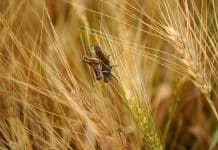This article is part of a series of informative animal health articles. The series goes hand in hand with the #VideoVet video series – watch the video below.
Several tick species are prevalent in South Africa and can be divided into two broad groups – hard ticks and soft ticks. These, in turn, include single-host, two-host and three-host ticks.
Tick control is applied mainly to: Protect hosts from irritation and production losses; prohibit the formation of lesions that can become secondarily infected; prevent damage to hides and udders; reduce toxicosis and paralysis; and, most importantly, prevent animals from being infected with a wide variety of disease-causing agents.
Proper control also prevents tick species from spreading to and infesting unaffected areas and limits disease transmission. It is important to know which tick species are prevalent on your farm, as control measures differ for the various hosts. For example, control measures for a single-host tick will be different from that of a three-host tick.
Different control measures
The detrimental effects of ticks on animals are well-known, so it is important to decide on suitable measures to protect animals. Ticks can be controlled in different ways, the most common being chemical control (known as acaricides or antiparasitics) or biological control (which involves oxpeckers and chickens). The most widely used control method is the treatment of hosts with acaricides to kill attached larvae, nymphs and adults.
During the first half of the century, arsenic trioxide was the most commonly utilised acaricide. Subsequently, organochlorines, organophosphates, carbamates, amidines, pyrethroids and macrocyclic lactones have been used in different parts of the world. However, it was necessary to introduce new compounds, such as phenylpyrazoles, due to the development of resistance in tick populations.
Acaricides can be applied using a spray dip, plunge dip or pour on, or it can be injected. The method must be suited to your farm. The plunge dip is a commonly used method of tick control in which the animal is completely immersed in the dipping compound. A dip tank, an electric or diesel pump and access to water are required for plunge dipping.
Spraying the dipping compound
Spray races are also widely used. In this instance, the animal walks through a race where it is sprayed with the dipping compound. For this method, you only need a spray race, an electric or diesel pump and access to water.
In the case of hand spraying the dipping compound is applied to each animal with a hand-operated spray. This process is time consuming and requires a back-pack spray. Hand dressing or spot treatment involves treating the specific sites where ticks commonly occur. Tick grease, oil or dipping compound can be used.
Pour-on’s and injectable agents represent the latest approach and are very effective. When choosing spray race or plunge dipping, you can use Taktic® Cattle Spray (with amitraz as an active ingredient) available from MSD Animal Health. MSD Animal Health supplies Delete® All (amitraz and deltamethrin) or Avotan® Plus Pour-On (abamectin and fluazuron) that are available as pour-on agents, while Solution® 3,5% L.A. (ivermectin and abamectin) is an appropriate injectable.
Tick resistance
No matter which product is used, there is always the chance of ticks building up resistance to a specific agent. Resistance is the ability of certain tick species to tolerate doses that would otherwise prove lethal to most individuals in a normal tick population. When resistant ticks survive, genetic resistance is spread.
Correct treatment
It is very important to follow the directions when applying any form of tick control. It is also necessary to thoroughly mix the dipping compound used, if required. Home-made remedies can be ineffective and may lead to even greater resistance in ticks. It can also be extremely poisonous and can damage the animal’s skin. It is therefore strongly recommended to only use approved products.
Solution® 3,5% L.A.

Reg. No. G3689 (Act 36/1947).
Namibia Reg. No. V06/18.1.2/651 NS0. Composition: Ivermectin* 2,25% m/v, abamectin* 1,25% m/v. (*Macrocyclic lactone).
Indications: An antiparasitic remedy for cattle and sheep. Solution® 3,5% L.A. has a long residual action on internal as well as external parasites, which includes the control and re-infestation of blue ticks for up to 54 days.
Dosage: 1mℓ/50kg body mass subcutaneously.
Pack size: 50 mℓ and 500 mℓ vials.
For more information, contact your MSD Animal Health representative or visit www.msd-animal-health.co.za. To watch more videos in this series, click here.







